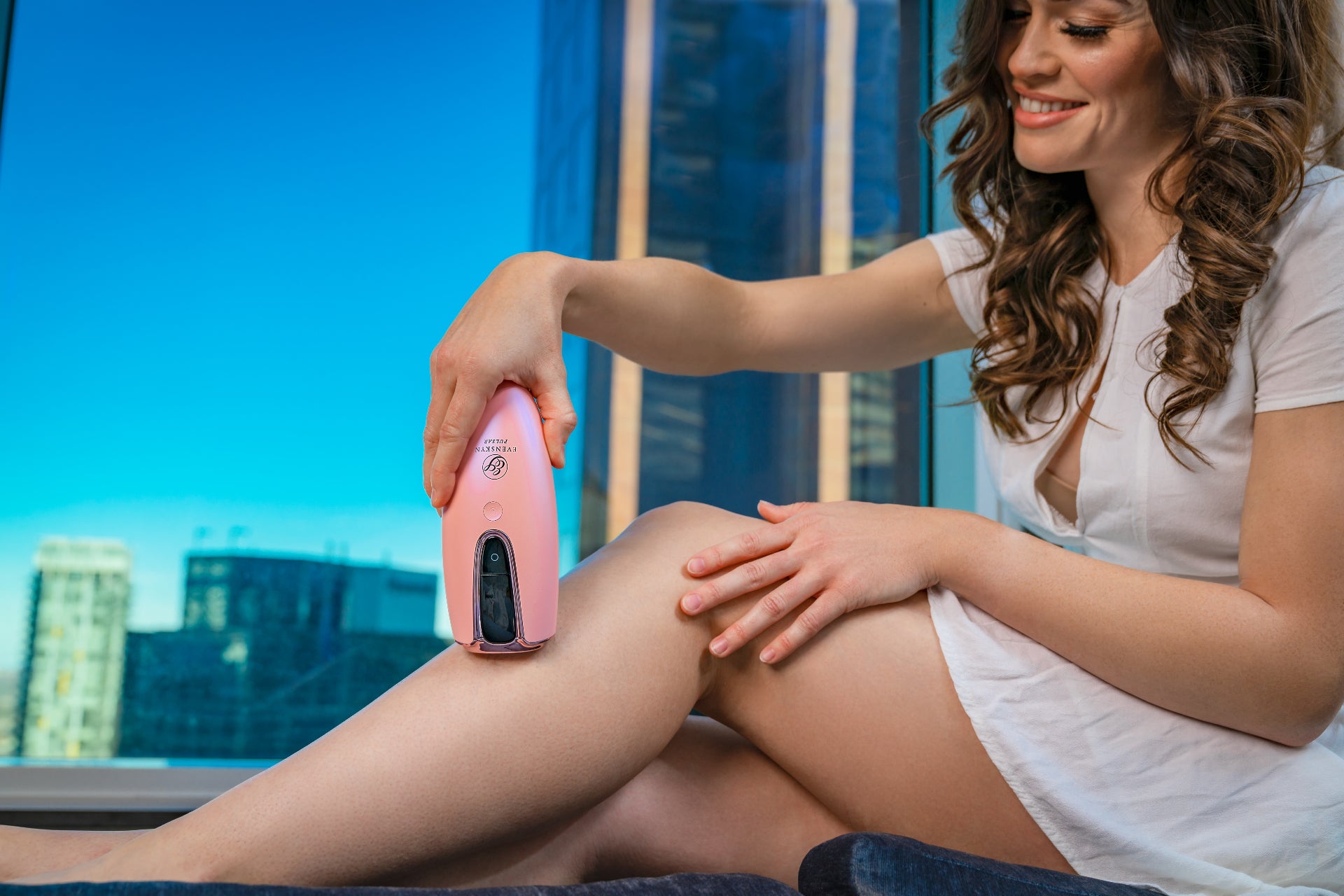Introduction
Intense pulsed light (IPL) based hair removal devices utilize high‐energy light flashes, with a broad wavelength spectrum. These pulses act on the melanin in the hair, and make the hairs go into their resting phase and the targeted hairs fall out. (1,6). The effectiveness of the IPL based hair removal treatments have been well established in various clinical studies including a 2015 study, which showed statistically significant hair reduction results (83.3 % at one-month and 78.1 % at three months) post the novel IPL treatments. (11)
However, there are certain factors including the skin tone and hair colour of an individual, which impact the effectiveness of the IPL hair removal treatment. We will discuss these factors today in detail.

Variance of Effectiveness of IPL treatments with Hair Tone
IPL treatment works on the mechanism of absorption of light by the melanin in the hair. There are certain hair tones, which do not contain any melanin or enough melanin and hence IPL treatment might completely fail in these hair tones as there will be very less or no light absorption. There are some other hair tones, which contain some other type of melanin and IPL is not effective in such hair tones as well.
The best candidates for hair removal are darker hair. Light hair shades including light blond, white and grey hair have low amount of melanin, and hence not suitable for IPL hair removal treatment. Individuals with Red hair are also not responsive to IPL, as Red hair contain some other type of Melanin. (3)
An effective IPL device, EVENSKYN PULSAR, which is one of the newest devices to gain FDA approval, in its manual, clearly lists the hair tones, in the form of a hair colour chart, that are suitable for IPL treatment. Refer to the chart below to see if your hair tone is suitable for IPL treatment or not. (10)
Variance of Effectiveness of IPL treatments with Skin Tone
Fitzpatrick scale, developed in 1975, measures and classifies the skin type based on the amount of pigment in the skin and skin’s reaction to the exposure of the sun. The scale classifies the skin types on a scale of 1 to 6, depending on the colour and shade of the skin.
Lighter skin tones are the ideal targets for the IPL treatments. As the contrast between the target spot colour and the regular skin colour increases, more IPL light is absorbed by the Target spot and the effectiveness of IPL treatment increases. Lighter shades of skin (Fitzpatrick scale skin types of 1 to 3) are best suited for IPL treatments. Darker skin tones (Fitzpatrick Skin Types 4-6) are not considered to be the good candidates for IPL. With darker skin tones, the light absorption by skin surrounding the problem area increases, making the treatment ineffective as well as resulting in an increased risk of injury. (7) Refer to the Fitzpatrick scale below to identify the suitable IPL light intensity for your skin tone
|
Fitzpatrick skin type |
Skin colour |
IPL Light intensity |
|
Type 1 |
Ivory |
6-8 |
|
Type 2 |
Fair or pale |
5-7 |
|
Type 3 |
Fair to beige, with golden undertones |
4-6 |
|
Type 4 |
Olive or light brown |
2-4 |
|
Type 5 |
Dark brown |
You cannot use the device |
|
Type 6 |
Deeply pigmented dark brown to darkest brown/ black |
You cannot use the device |

A study presented in ASLMS,2007, also evaluates the efficacy of IPL skin and hair removal treatment on darker skin tones. The study included a total of 147 subjects, of which 100 subjects had the Fitzpatrick skin type 4 and 47 had Fitzpatrick skin type 5. The patients were treated up to 7 times for hirsutism and cosmetic hair removal, up to 10 times for mild to moderate inflammatory acne vulgaris and up to 6 times for benign epidermal pigmentation including freckles, PIH, melasma, and other benign pigmented lesions.
The study concluded there was in general a poor response and lesser efficacy of IPL treatment on darker skin tones, and the treatment efficacy only improved after multiple treatment cycles. In general, there was little reduction in regrowth of hair follicles after a single treatment, a moderate reduction only after 3-4 treatments, and a good reduction after 7 treatments. Also patients experienced some mild side effects including Mild erythema around face and Burns around face and legs.(8)
EVENSKYN PULSAR manual clearly lists the skin tones, in the form of a skin colour chart, that are suitable for IPL treatment. Refer to the chart below to see if your skin tone is suitable for IPL treatment or not (10)
Conclusion
Advances in light‐based therapies have broadened the range of hair-removal treatment options. IPL based hair removal treatments are also widely used for multiple skin tone and hair colours. However, the effectiveness of IPL devices is higher on lighter skin colours and darker hair tones. Hence, it is imperative for you to understand your skin and hair shade, to correctly determine the light intensity for your IPL device for long lasting and safe treatment outcomes.

References
- https://onlinelibrary.wiley.com/doi/10.1111/j.1610-0387.2007.06513.x
- https://www.darstdermatology.com/wp-content/uploads/2014/01/IPL-Pre-and-Post-Treatment-Instructions.pdf
- https://www.philips.com.au/c-f/XC000003324/is-philips-lumea-suitable-for-all-skin-and-hair-types
- https://www.healthline.com/health/beauty-skin-care/fitzpatrick-skin-types
- http://www.justaboutskin.com/2015/09/intense-pulsed-light-ipl/
- https://www.google.com/url?sa=D&q=https://www.ncbi.nlm.nih.gov/pmc/articles/PMC3390232/&ust=1603364580000000&usg=AOvVaw0-GZCY8WLZQ14g8UKZfNhp&hl=en&source=gmail
- http://www.justaboutskin.com/2015/09/intense-pulsed-light-ipl/
- http://citeseerx.ist.psu.edu/viewdoc/download?doi=10.1.1.496.9639&rep=rep1&type=pdf
- https://pubmed.ncbi.nlm.nih.gov/31023099/
- EvenSkyn Product Manual










Leave a comment
All comments are moderated before being published.
This site is protected by hCaptcha and the hCaptcha Privacy Policy and Terms of Service apply.